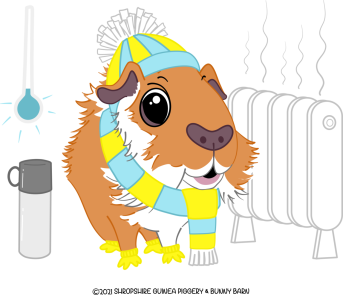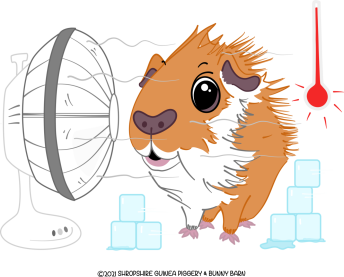
Seasonal advice for outside piggies
Winter.
Mid October is the time when you should be preparing your pets for the winter. If your pets are normally inside, then you have nothing to do, as they are nice a snug in your warm homes. If however, your pets are outside, now is the time to bring them in if you can.
If your Guinea pigs or rabbits live outside then it's important to prepare their accommodation for winter. Guinea pigs hate the cold, anything below 10C is too cold for them and they should be brought inside your home, but rabbits cope moderately well in cold temperatures as long as they have a warm dry area to shelter. Wild rabbits' warrens are insulated as they are underground which prevents them dropping below freezing. As a hutch is above ground you need to takes steps to ensure it provides enough protection to your pets to keep their bed area above the freezing outside temperatures.
Moving the hutch into a shed or garage is a great way to help keep it warm. However, do not put it in a garage that you also use for your car as the fumes pose a health hazard. Make sure they still get natural lighting ( a shed with a window?) or leave a light on for them, don’t let them spend the winter in the dark! We won't like that so neither would your pets. If your rabbits live in a shed or playhouse all the time, rather than a hutch, you can add insulation to the walls to help to keep it warm.
You need a hutch in a good state of repair.
For outside hutches, a hutch can only provide protection if it's in good repair, so, if you haven't already, now is the time to make any repairs to your pet's home and make sure it's watertight or if you can afford it, but a new one. They will be cheaper at this time of year!
Do a hutch check. Start by checking the inside of your hutch for signs of water stains or damp that may indicate water is getting in. Signs of damp near the top of the hutch may indicate a problem with the roof or walls whereas damp near the bottom may be an indication of water rising through the base of the hutch.
If the roof has minor damage or leaks you may be able to repair it with roof sealant . If the roof is in poor condition then it may need completely replacing altogether. Most hutch roofs are made from marine plywood covered in roofing felt. Bear in mind that roofs with a slight slope, to prevent sitting water, will have a longer lifespan than flat roofs.
Renew Preservative- The sidewalls of rabbit hutches also need to be weatherproofed. The protective coating will wear and will need to be reapplied every few years - more if necessary. This will stop the damp entering the hutch and also protect the wood from rotting. To renew the stain/paint/varnish, give it a good brush with a stiff brush to remove and dirt and loosen the paint, sand it lightly, re brush to remove any debris and then repaint. If you are painting over the same colour you won't generally need as many coats as starting from scratch. Most water-based wood preservatives are pet safe.
Rising damp from the ground is an issue for rabbit hutches. Hutches should be raised off the floor to prevent the base from becoming damp and rotting. If your hutch doesn't have legs fitted then placing a brick or two at each corner will raise it enough to allow air to circulate and reduce damp. This will also prevent rats or mice from sleep underneath. If you're in an area that is at risk of flooding, you will need to ensure the accommodation is sufficiently high of the ground not to cause a risk to your rabbits.
Keeping Warm & Dry
A well-built hutch in good repair is a good start to keeping your rabbit warm over winter but there are a few extra steps you can take to insulate it further.
Reducing Drafts
Large mesh doors can be partially covered with clear Perspex or plastic, allowing your pet to see out and the sun to come in but preventing wind and rain from entering. Look for panels designed for greenhouses. Ventilation is still important though, so leave a gap of several inches for this. Turning the hutch so the front faces away from the wind will also help reduce wind and rain through the mesh areas. If it's not possible to turn the rabbit hutch around then put something just in front to block direct wind and rain. Better still move your hutch to a more sheltered space in your garden.
Insulating the Hutch
Covering the whole hutch with an old blanket or an carpet and then a tarpaulin or plastic sheet with bricks on the top will help keep the heat in and the weather out. During the day leave the front open for ventilation and at night cover the majority of the hutch leaving a smaller area for ventilation. You can also purchase hutch covers that offer a smarter looking alternative and are well made and suitable and safe for the job in hand.
Bedding
Everyone needs a warm snug bed area. This should be the equivalent of a box with an entrance hole. Often hutches have a bed area divided from the main hutch. If a sleeping section isn't available or it's very large, then provide a smaller box as well. Plastic ones are great for this as they keep the warmth in better. A smaller area will warm up around your pets and keep them snug. Newspaper can be used to line the floors/walls underneath the bedding.. Also provide extra bedding and a thick layer of litter for the floor. Straw is a better insulator than hay for rabbits,( do not use straw for piggies) so add it to the bed area over winter for extra warmth, it's fine if your rabbit nibbles some but they'll still need hay for eating. Add lots and lots of hay too to keep the bed area warm.
Check regularly that the hutch is dry from wee, because if it is cold, your pet is more likely to pee inside their bedding area and not go out, so it gets wet faster and they just sit in it, This causes more health problems to bums and feet.
Heating
In a hutch, a Snugglesafe microwavable heat pad (about £15) is a good option (don't use a hot water bottle as your pet may chew it). Change it morning and evening to give them all day warmth.
Water bottles
Change their water bottle at least once a day as it can freeze up in very cold weather.
Summer
Even though your Guinea pigs don't like the cold, Guinea pigs also struggle in the heat and aren’t built for basking in the sun! Here are some top tips to help keep them cool in the summer heat.
- If your Rabbit or Guinea pigs are in a warm spot, help to keep them cool by wrapping an icy water bottle in a small towel and placing it in their cage/hutch. You can also buy purposely made cool pads, that you pop in your freezer overnight and let your pet lie on them and enjoy the coolness throughout the daytime.
- Always ensure that your guinea pig has plenty of fresh water in their bottle. Just like us, we drink more cold drinks in the summer to help us cool down. Water intake can fluctuate and water is crucial for preventing dehydration. If the water id warm or hot they will not drink it so change it twice a day in the summer.
- Move their hutch out of direct sunlight and move it to a shady spot in the garden. Temperatures can climb very rapidly in a hutch in the summer sun and every year we hear of lots of pets that die because of Heat stoke.
- Some people place a cool stone or tiles in their pets hutch. These will provide a cool surface for your pet to rest on.
- Avoid exposing your pet to prolonged sun exposure and they can get sunburnt or suffer from heat stroke just like us humans do.
- If the weather is extremely hot, bring your outdoor pets inside into a cooler room.
- Do not point an electric fan directly on them. Instead, point it away and around the room so that the air circulates around the room.
- Make sure that their outdoor run is covered up by a blanket or old towel, or place it in the shade. Remember though that the suns position changes during the day so keep an eye on the.
- Make sure they have cool hiding places in their run too – a tunnel or cardboard box tipped on its side is a fun, shady place for them to explore. Don't use plastic igloos or houses. The temperature underneath these can get very hot in the full sun.
- Make sure you keep their vegetables in the fridge. They will lovely and cool to eat at the end of the day. Try to give more watery veg too like cucumbers and watermelon, they love them when it is hot.
You’ll need to be extra careful if your pet is more at risk from the heat:
- Long-haired breeds. These rabbits and guinea pigs are wearing a really thick fur coat on the hottest of days. Give them a hair cut and give them a bath. They might not enjoy it at the time, but they will feel a lot better afterwards.
- Overweight pets. If your rabbits or guinea pigs are carrying a bit of extra weight, their body will have to work harder to stay cool.
- Very young or old pets. They can struggle to control their body temperature in really hot or cold weather. This can be due to their even tinier size, or that they are particularly fragile due to a health condition.


